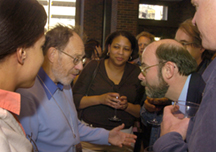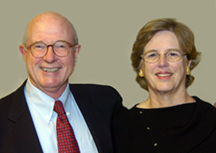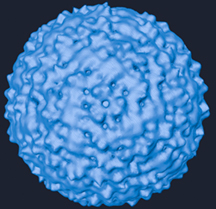
October 7, 2005
Purdue alumnus contributes to future of structural biology
WEST LAFAYETTE, Ind. – Purdue University on Friday (Oct.7) announced a major step toward creating a new home for one of its most internationally renowned research groups, thanks to alumnus Wayne T. Hockmeyer and his wife, Mary.

|
A $5.3 million commitment from the Hockmeyers will go toward the construction of a building to house the structural biology group. The group is a division of the College of Science's Department of Biological Sciences that currently occupies the Center for Structural Biology in the basement of Lilly Hall. The announcement will be made tonight at the President's Council annual dinner.
Fund raising continues for the $25 million in private gifts needed to fund the projected $30 million building. The facility will be named the Wayne T. and Mary T. Hockmeyer Hall of Structural Biology, subject to ratification by the university's board of trustees.

|
Structural biology, a discipline that involves the use of ultra-modern imaging technology to probe the inner workings of cells, viruses, proteins and other tiny but pivotally important elements of the living world, has become one of the most promising fields in science over the past several decades.
"Purdue's structural biology group has distinguished itself repeatedly as one of the most respected research teams in the nation," said Purdue President Martin C. Jischke. "They have contributed to our university and the scientific establishment as a whole, and Wayne and Mary Hockmeyer's pledge is a necessary first step toward providing them with the space they need to continue and advance their work."
Wayne Hockmeyer, who graduated from Purdue in 1966, recalled that the group has been housed in Lilly as long as he can remember.
"The current facilities were there when I was an undergraduate," said Hockmeyer, who went on to found MedImmune, which is based in Gaithersburg, Md. "Purdue's structural biology group is one of the best in the world, and they will be able to retain top faculty more easily with first-class facilities. I hope this gift will speed the process of providing them with a new home, which could be a boon to both fundamental science and, hopefully, the development of new drugs."

|
The building, to be built adjacent to Discovery Park, is still in its planning stages, and no architect or design has yet been specified. However, some of the preliminary plans give a rough idea of what facilities the finished building will offer.
At this point, the tentative plan is for a 77,900-square-foot facility that will accommodate 143 faculty, postdoctoral researchers and graduate students. Approximately 13,000 square feet will be lab space for individual faculty, while an additional 15,000 square feet will be general lab space dedicated to the larger equipment necessary for structural biology research. Included in this general area will be labs for
• electron microscopy,
• X-ray diffraction,
• large-molecule crystallization,
• nuclear magnetic resonance spectroscopy,
• cell and virus culture, and
• analytical and biophysical instrumentation.
Plans also include space for offices, conference rooms and a multimedia viewing area for 100 attendees.
Richard Kuhn, who is head of the biology department, said the building's facilities would be a benefit to the field and the nation.
"The structural biology group's overall goal is to continue pushing the boundaries of our knowledge beyond the genome by discovering the molecular mechanisms that underlie biology," he said. "The National Institutes of Health recently awarded us $18 million in grants to help study viruses thought to have potential as biological weapons. The grants will fund both basic research on these viruses and the potential development of antiviral agents to fight against them. This new building will give us the facilities to do better work that is vital both to basic science and to national security."
Some recent examples of the group's work include:
• A team including Michael Rossmann, Kuhn and Timothy Baker mapped the structure of the dengue virus, knowledge that could prove important to the development of antiviral drugs. Dengue, a relative of West Nile virus and yellow fever, is spread by mosquitoes and kills more than 24,000 people annually. The group also determined the structure of the immature dengue particle while still within its cellular host, which could shed light on the virus' development process.
• Rossmann's team analyzed the structure of the baseplate of the T4 virus, which commonly infects E. coli bacteria. The baseplate is a complex structure made of 16 types of proteins that allows T4 to attach itself to the surface of E. coli. The team also obtained clearer pictures of how the baseplate alters its shape as T4 prepares to pierce E. coli's cell membrane. The team took images of the baseplate from different moments in the process, which resembles a flower opening, and transformed them into a brief animated movie, helping scientists understand how infection occurs.
• Kuhn's team determined the structure of the West Nile virus by determining the orientation of the major surface proteins in the viral particle. Because these proteins allow the virus to invade a host cell, the research could be a step forward in combating the deadly mosquito-borne disease.
• William Cramer's team obtained a complete molecular-scale picture of how plants convert sunlight to chemical energy. The effort revealed information not only about a process crucial to life on Earth, but also about how cells handle and distribute energy.
• David Sanders' research team replaced the genetic material inside the Ross River virus with helpful genetic material, enabling them to alter the liver cells of living mice without producing the harmful side effects that have accompanied the use of other viruses. Sanders' team also has redesigned the shell of Ebola, transforming the feared virus into a benevolent workhorse for gene therapy. And as one of the first gene bearers that can be inhaled, the transformed virus might prove valuable in fighting lung disease.
• Baker's team determined the structure of a reovirus, which can cause diarrhea in humans, at better than twice the resolution previously available. The effort will allow them to look at the components of the viral machine to see how genetic materials are produced and exported into a host cell, an advance that could aid in the development of antiviral agents.
• Carol Post's group has found the likely reason why a WIN compound – a prototype drug for curing colds – is showing so much promise. The flexible molecule's structure may allow it to shimmy inside the proteins that form the virus' outer shell and alter them to the point where the virus cannot complete the infection process.
Wayne and Mary Hockmeyer of Bethesda, Md., both grew up in Evansville, Ind. He earned his bachelor's degree in entomology from Purdue in 1966 and his doctorate from the University of Florida in 1972. Purdue awarded him an honorary doctorate in 2002. He returned that same year to participate in the Old Masters' program, which allows current Purdue students to interact with past graduates to gain perspective on confronting challenges in their careers.
After three months in his first job at Dow Chemical Co. in Michigan, he was commissioned in the Army, and, following airborne and special forces training, was sent to Vietnam in 1968 with the 5th Special Forces Group. The Army assisted with Hockmeyer's return to the University of Florida, where he earned his doctorate. He rose to the rank of lieutenant colonel and, during his 20-year military career, authored many research papers with particular emphasis on the development of malaria vaccines. He also was awarded the Legion of Merit, Bronze Star, Meritorious Service medal and the Army Commendation medal. The Legion of Merit and Meritorious Service medals were each separately awarded twice.
Following his military career, including the last six years as chairman of the Department of Immunology at the Walter Reed Army Institute of Research, Hockmeyer founded MedImmune Inc. in 1988 and served as president and CEO until 2000.
Hockmeyer was elected to serve on MedImmune's board of directors in 1988 and became chairman of the board of directors in 1993. The company developed and now markets Synagis®, an FDA-approved monoclonal antibody to prevent an infectious disease, and FluMist®, a live attenuated intranasal influenza vaccine. According to the company's 2004 annual report, MedImmune is generating more than $1 billion in annual revenues and investing more than $342 million in research and development. The company has approximately 2,000 employees worldwide.
In addition to his duties as MedImmune's chairman, he also serves as president of MedImmune Ventures Inc., the company's venture capital subsidiary, which was launched in 2002. He also is a member of the Maryland Economic Development Commission and the Governor's Workforce Investment Board and serves on the boards of directors of several companies, including Advancis Pharmaceutical Corp., Idenix Pharmaceuticals Inc., GenVec Inc., TolerRx and Vanda Pharmaceuticals Inc.
Mary Hockmeyer earned her doctorate in human development at the University of Maryland.
Writer: Chad Boutin, (765) 494-2081, cboutin@purdue.edu
Sources: Wayne T. Hockmeyer, (301) 398-4257, hockmeyerw@medimmune.com
Richard Kuhn, (765) 494-1164, kuhnr@purdue.edu
Purdue News Service: (765) 494-2096; purduenews@purdue.edu
PHOTO CAPTION:
Structural biologist Michael G. Rossmann, at left, speaks with his long-time collaborator Richard Kuhn, head of Purdue University's Department of Biological Sciences, at a party celebrating Rossmann's 75th birthday. Rossmann, the Henley Distinguished Professor of Biological Sciences, is credited with being one of the pioneers of the structural biology field, which has provided numerous insights into the inner workings of viruses, proteins and other fundamental elements of the biological world. (Purdue News Service photo/Dave Umberger)
A publication-quality photo is available at https://www.purdue.edu/uns/images/+2005/rossmann-kuhn.jpg
PHOTO CAPTION:
This figure shows a surface-shaded image of the West Nile virus particle produced by Purdue University biologists using cryoelectron microscopy. The surface is composed of proteins that enable the virus to bind with and invade a host cell. The particle is approximately 50 nanometers in diameter, or about 1/1000th of the width of a human hair. (Purdue Department of Biological Sciences image)
A publication-quality photo is available at https://www.purdue.edu/uns/images/+2005/kuhn.westnile.jpg
To the News Service home page